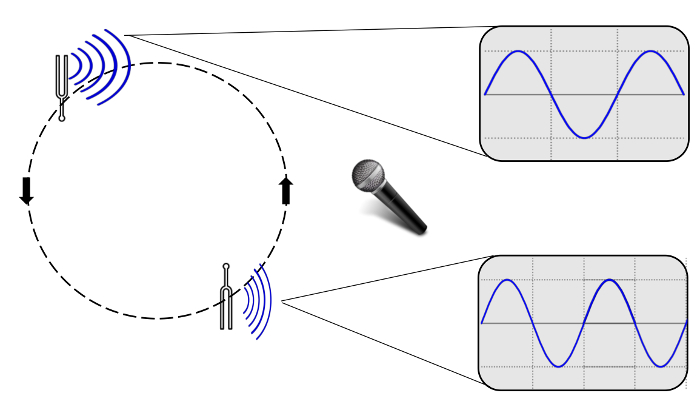Sound Waves and Doppler Shift
Source: Arianna Brown, Asantha Cooray, PhD, Department of Physics & Astronomy, School of Physical Sciences, University of California, Irvine, CA
Waves are disturbances that propagate through a material medium or empty space. Light waves can travel through a vacuum and some forms of matter, and are transverse in nature, which means that the oscillations are perpendicular to the direction of propagation. However, sound waves are pressure waves that travel through an elastic medium like air, and are longitudinal in nature, which means the oscillations are parallel to the direction of propagation. When sound is introduced to a medium by a vibrating object, like the vocal chords of a person or strings in a piano, the particles in the air experience forward and backward motion as the vibrating object moves forward and backward. This results in regions in the air where the air particles are compressed together, called compressions, and other regions where they are spread apart, called rarefactions. The energy created by a sound wave oscillates between the potential energy created by the compressions and the kinetic energy of the small movements and speeds of the particles of the medium.
Compressions and rarefactions can be used to define the relationship between sound wave velocity and frequency. The goal of this experiment is to measure the speed of sound in air and explore the apparent change in frequency for an object emitting sound waves while in motion, called the Doppler effect.
1. Measuring the Speed of Sound
- Set up: two speakers facing one another on an optical bench. One speaker should be plugged into a function (signal) generator on one side of a BNC tee, with the other side of the BNC tee connected to channel A on the oscilloscope. The second speaker should be plugged into channel B in the oscilloscope.
- Turn on the signal generator and oscilloscope, and adjust the dial on the generator to produce a 5 kHz wave. The speaker connected to the function generator should prod
Room Temp: 20 °C
Expected velocity: v = 331.4 + 0.6(20) = 343.4 m/s















